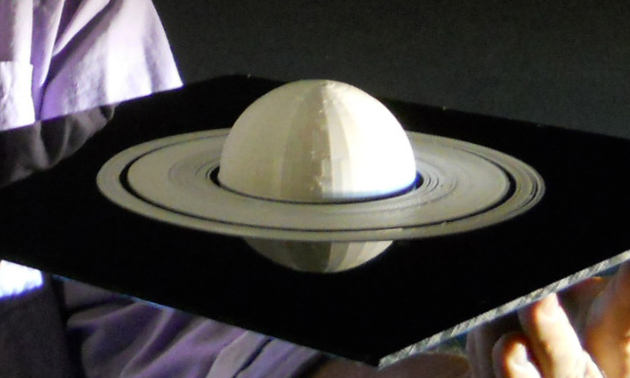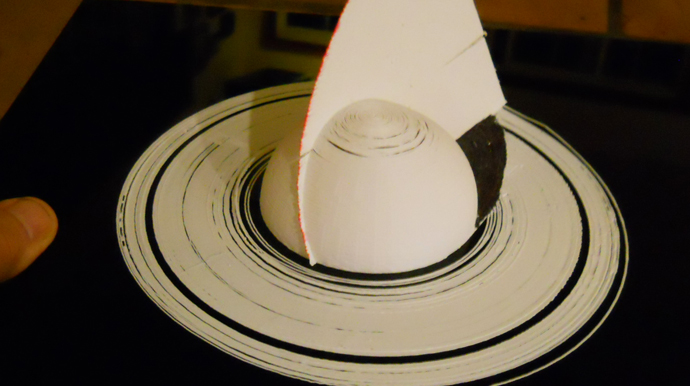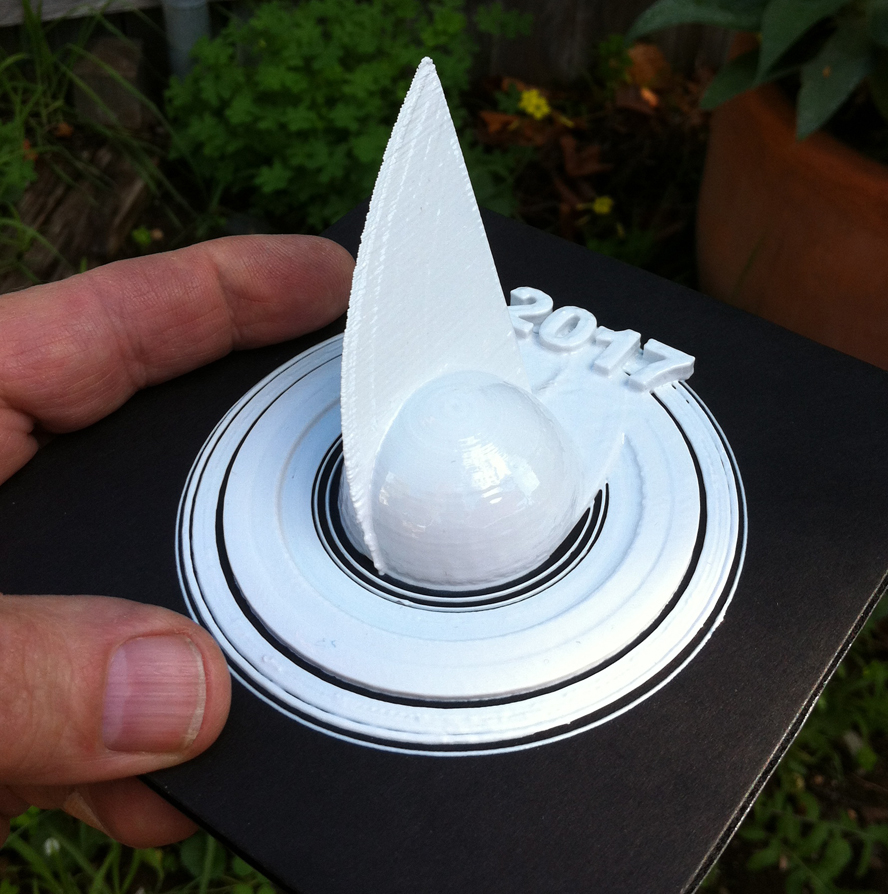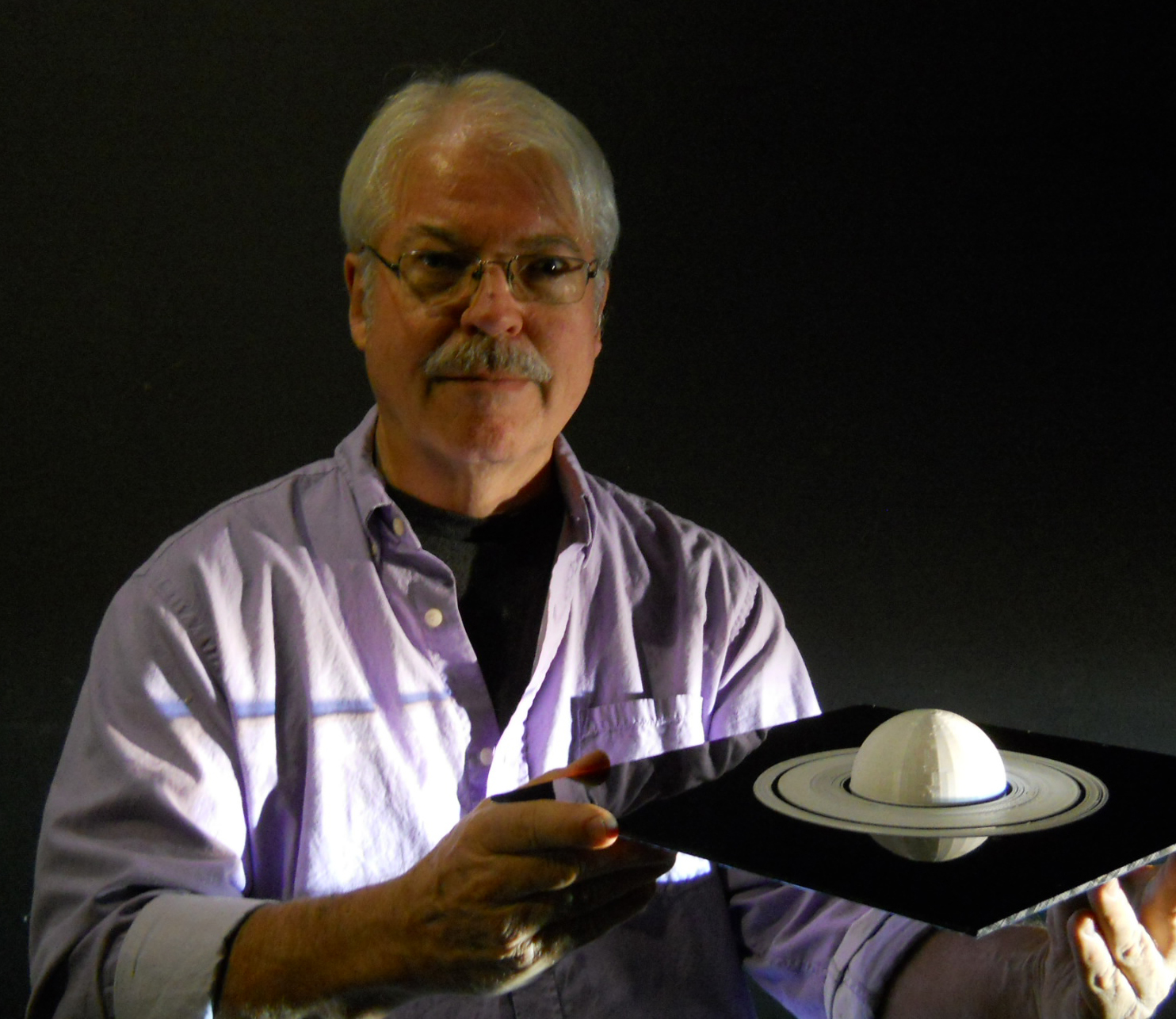3D Print Files: Saturn and its RingsDownload Free of Charge
The images above and at right shows SCI's proprietor Dave holding a 3D print of the .stl file mounted on a shiny black acrylic panel, in which the hemispheroid is reflected, seeming to make a whole planet. Use this Saturn model as a backdrop for your free Cassini Spacecraft scale model.
Cassini's 2017 Proximal Orbits
Here is the large-size version of Saturn with its rings and planet shadow shown in the picture above, with the addition of a "sail," which illustrates the "proximal" orbits that the Cassini Spacecraft will be flying, beginning in April 2017. These 6.5-day orbits will repeatedly plunge the spacecraft in between the D Ring and the upper atmosphere, going more than 121,000 km/h. Periapsis of the final orbit in September 2017 will take Cassini into Saturn's atmosphere for intentional disposal. A smaller, simplified, and more robust model than this one is the "98mmProximalSaturn.stl" file listed below. The files for all the larger, more delicate versions (such as the one at left) are also available below, for downloading free of charge.
Download Here Free of Charge.STL Download an .stl file ready to send to your printer. Left-or-right-click (depending on your setup) on the link below to select "Download Linked File" (or equivalent) from your browser options:First, the "easy" small object - about 4 inches wide This is the version that will probably give the best results overall; it's pictured at right (click to enlarge). This object isn't as delicate as the other options offered on this page, it's small and it doesn't take all day to print. As a model it is fairly accurate, but its B Ring is thickened to help make the object easier to handle. There are only two strands to represent the innermost ring, the D Ring. The model shows Cassini's 2017 orbit, and it may be printed along with the "2017.stl" file below to create the object depicted. If used, the 2017.stl file can be positioned in such a way that it holds together the outermost part of the A Ring and the outermost F Ring, which are otherwise disconnected from the rest of the model.
This is the version that will probably give the best results overall; it's pictured at right (click to enlarge). This object isn't as delicate as the other options offered on this page, it's small and it doesn't take all day to print. As a model it is fairly accurate, but its B Ring is thickened to help make the object easier to handle. There are only two strands to represent the innermost ring, the D Ring. The model shows Cassini's 2017 orbit, and it may be printed along with the "2017.stl" file below to create the object depicted. If used, the 2017.stl file can be positioned in such a way that it holds together the outermost part of the A Ring and the outermost F Ring, which are otherwise disconnected from the rest of the model.
98mmProximalSaturn.stl
2017.stl
NOTE: If your computer changes the filename extension, change it back to ".stl" after downloading.
Next, files for the larger, more accurate, more delicate versions, pictured in the upper part of this page.SaturnWithShadowOnRings.stlFILE IS 5.0 MB
SaturnAndRings.stl
NOTE: If your computer changes the filename extension, change it back to ".stl" after downloading.
SaturnWithShadowOnRings.scad
SaturnWithProximals.scad
98mmProximalSaturn.scad
NOTE: If your computer changes the filename extension, change it back to ".scad" after downloading.
Here's an optional baseplate that you might wish to print beneath SaturnAndRings, if you have the capability to print using a material of contrasting color. There are two approaches: one is to put both .stl files into your printer and arrange them. The other way is to edit the .scad file to make a single .stl file that integrates them. Some printers may cause the baseplate to warp, unless slicing is adjusted to prevent it.
BaseplateForSaturnAndRings.scad
NOTE: If your computer changes the filename extension, change it back to ".scad" after downloading.
Designed for printing using FDM, this .stl object only requires a single extruder machine; no external support material is required. White or cream-colored material recommended. If your printer allows, you might wish to print this model directly onto a square of black plastic or black foamcore, etc. Note that your printer may lay down a "skirt" outside the object before printing it. If it does so, don't confuse it with one of Saturn's rings, which it might resemble.
In removing the model from the printer platform, you'll have to be extraordinarily careful not to break the very thin F Ring, which is the single strand at the preimeter of the model (once the "skirt," if any, has been discarded). Laying the model down on a flat surface such as black foamcore after removing it from the printer, carefully adjust the F Ring so it is circular and separate from the A Ring.
After printing an object in ABS plastic, you might wish to expose your model to an environment of acetone fumes, which will condense on the model, dissolving and smoothing its surface. This will also make it adhere to a substrate for display.
Now pushing forward within the limits of desktop FDM, I'd be happy to get your comments; please write them in the box below, and I'll post them on this page to share with other users if applicable. Please indicate your email address, but I won't publish it unless you were to specifically request. If you'd like to send .scad or .stl files that we can test and then possibly offer (with attribution) for downloading free of charge, please send them as an attachment to dave (at) SpacecraftKits.com.
Thank you.
— Dave
|
